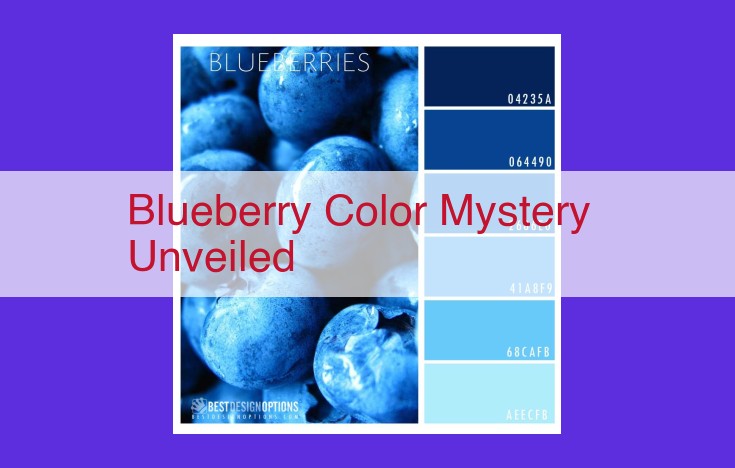Unveiling The Blue Enchantment Of Blueberries: Exploring The Role Of Anthocyanins And Ph
Unravel the botanical mystery behind the vibrant blue of blueberries, exploring the role of anthocyanins, compounds responsible for their captivating hue. Discover how pH plays a crucial part in determining their color variations, and delve into the complex interactions with other flavonoids that influence their stability, color, and antioxidant activity. Witness the practical applications of anthocyanins in various industries, showcasing their versatility beyond the realm of aesthetics.
The Intriguing Enigma of Blueberry’s Vibrant Hue
Unveiling the Secrets of Nature’s Azure Gem
Have you ever wondered about the vibrant allure of blueberries? What gives these tiny berries their captivating azure hue? _Anthocyanins, the key pigments responsible for their tantalizing color, hold the answer to this enigma.
Anthocyanins: The Artists of Nature
Anthocyanins, a group of potent flavonoids, are the masterminds behind the spectacular color palette of blueberries. Their structure, composed of sugar molecules and anthocyanidins, determines the diversity of shades we see.
pH’s Playful Dance with Color
The pH of the blueberry’s environment influences the anthocyanins’ color-changing magic. In acidic conditions, they transform from ruby red to deep purple, a transformation explained by the ionization of the anthocyanidin.
A Symphony of Flavonoids
Blueberry’s vibrant color is not a solo performance. Flavonols and flavones, other flavonoids, join the anthocyanin symphony, enhancing stability, color, and antioxidant power.
Unveiling the Chemistry of Anthocyanins: Unlocking Blueberry’s Vibrant Hue
The Building Blocks of Blue
Anthocyanins, nature’s pigments that adorn blueberries with their vibrant hues, are complex compounds with an intriguing structure. They consist of two main components: sugar molecules and anthocyanidins, the color-bearing element. These anthocyanidins are like paintbrushes, dipping into different shades of red, purple, and blue.
The Dance of Anthocyanidins
The diversity of blueberry colors can be attributed to the vast array of anthocyanidins they possess. Each variety of blueberry has its own unique blend of these pigments, resulting in a spectrum of hues from deep blue to blushing pink. Like a skilled artist, anthocyanidins orchestrate a color symphony within each berry.
pH’s Dance with Anthocyanin Color
In the captivating world of blueberry hues, pH plays a captivating role, orchestrating a mesmerizing color symphony. This enigmatic dance between acidity and alkalinity unveils the secrets of blueberries’ vibrant shades.
Unveiling the Molecular Ballet
At the heart of blueberry color lies anthocyanins, pigments that possess a remarkable sensitivity to pH changes. These anthocyanins consist of a sugar molecule attached to an anthocyanidin, a colorful compound responsible for the fruit’s characteristic tints.
As the pH varies, the ionization of the anthocyanidin triggers a color metamorphosis. In acidic environments (low pH), the anthocyanidin releases a hydrogen ion, becoming positively charged. This positively charged anthocyanidin exhibits red hues.
Conversely, in alkaline environments (high pH), the anthocyanidin absorbs a hydrogen ion, acquiring a negative charge. This negatively charged anthocyanidin displays purple or blue shades.
The pH Spectrum of Blueberry Hues
Blueberries showcase a fascinating array of colors, influenced by their pH levels. In acidic soils, blueberries develop redder tones, while in alkaline soils, they display bluer hues.
This pH-dependent color variation is due to the ionization of the anthocyanidins. As the soil pH increases, the ionization of the anthocyanidins becomes more pronounced, leading to the formation of bluer pigments.
Practical Applications of pH Control
Understanding the relationship between pH and anthocyanin color has practical applications in blueberry cultivation and processing. Farmers can manipulate soil pH to enhance the color of their berries. Food processors can adjust the pH of blueberry products to achieve desired hues.
By unraveling the captivating dance between pH and anthocyanin color, we gain a deeper appreciation for the vibrant artistry of blueberries. These delicious fruits offer a vibrant symphony of shades, each influenced by the intricate interplay of acidity and alkalinity.
Flavonoid Symphony: Anthocyanins and Their Companions
In the realm of blueberry color, anthocyanins take center stage, but they don’t play solo. They share the stage with a symphony of other flavonoids, such as flavonols and flavones. These compounds join forces, creating a harmonious blend that enhances the blueberry’s vibrant hue and unlocks a range of health-promoting benefits.
Flavonols, including quercetin and myricetin, contribute their own antioxidant potency, adding to the blueberry’s overall protective power. Meanwhile, flavones, such as apigenin, play a subtle yet crucial role in stabilizing the anthocyanins, safeguarding their vibrant color and preserving their antioxidant activity.
This delicate interplay between anthocyanins and their flavonoid companions creates a synergistic symphony of nutrients. Together, they paint the blueberry’s vibrant canvas, protecting its cells from oxidative damage, and contributing to its reputation as a superfood.
Beyond the Vibrant Canvas of Blueberries: Unveiling the Versatile Applications of Anthocyanins
In the realm of natural hues, anthocyanins stand as the enigmatic pigments that orchestrate the vibrant tapestry of blueberries. But their allure goes far beyond their captivating color. These compounds hold a treasure trove of practical applications that span multiple industries.
In the Culinary Realm:
Anthocyanins are culinary wizards, transforming food from ordinary to extraordinary. As natural colorants, they infuse pastries, beverages, and confections with an array of vibrant shades, from deep reds to alluring purples. Moreover, their antioxidant properties safeguard food against oxidative damage, extending shelf life and preserving freshness.
Pharmaceutical Promise:
Venture into the pharmaceutical arena, where anthocyanins are attracting increasing attention. Studies suggest they possess anti-inflammatory, cardioprotective, and neuroprotective effects. Their potential to combat chronic diseases, such as cancer and Alzheimer’s, is an active area of research.
Cosmetic Alchemy:
Delve into the world of cosmetics, where anthocyanins emerge as skincare and haircare heroes. Their antioxidant and anti-aging properties help protect skin from environmental stressors, reducing wrinkles and age spots. They also enhance hair growth and impart a lustrous shine.
As we unravel the secrets of anthocyanins, we gain not only an appreciation for the vibrant artistry of blueberries but also the boundless possibilities they offer across diverse industries. From culinary delights to pharmaceutical advancements and cosmetic innovations, the versatility of these remarkable pigments is a testament to nature’s boundless ingenuity.
